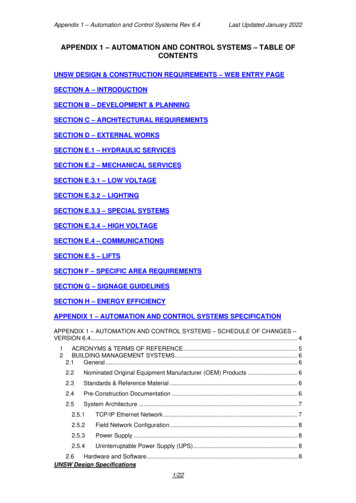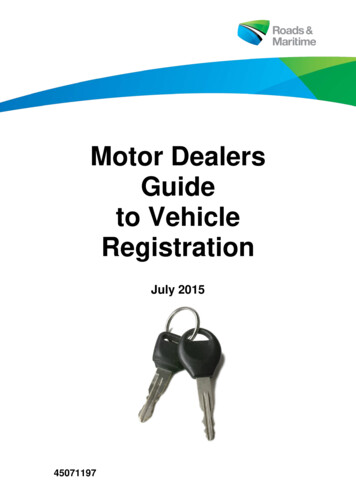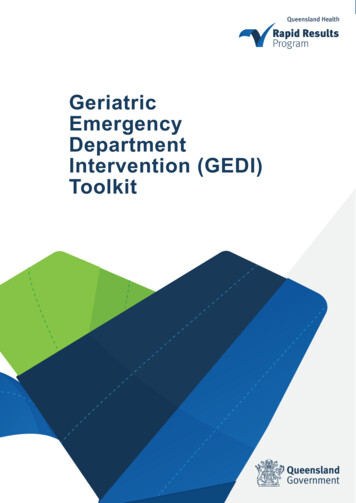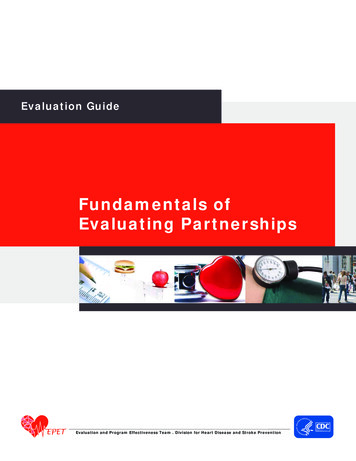
Transcription
Appendix 5-A, Appendix AAPPENDIX 5-A, APPENDIX A: ENVIRONMENTAL JUSTICE OUTREACHPLANCalifornia High-Speed Rail Authority Project Environmental DocumentSan Francisco to San Jose Project Section Environmental Justice Outreach PlanDecember 2019
San Francisco to San Jose Project SectionDraft Environmental Justice Outreach PlanProject Environmental Impact Report /Environmental Impact StatementSan Francisco to San JoseProject SectionEnvironmentalJusticeOutreach PlanJune 2016California High-Speed Rail Authority Project Environmental DocumentSan Francisco to San Jose Project Section Draft Environmental Justice Outreach PlanApril 2016Page 0
California High-Speed Rail Project Draft EIR/EISSan Francisco to San JoseProject SectionDraft EnvironmentalJustice Outreach PlanPrepared by:Kearns & West Inc.June, 2016
San Francisco to San Jose Project SectionDraft Environmental Justice Outreach PlanTable of Contents1. High Speed Rail Environmental Justice. 11.1 Overview of the Project and the Outreach Plan. 11.2 Regulatory Setting . 21.3 San Francisco to San Jose Project Section Demographics. 32. Environmental Justice Advocacy and Interest Groups . 73. Environmental Justice Outreach . 103.1 Outreach Strategy. . 113.2 Outreach Activities. 123.3 Outreach Implementation . 133.3.1 Public Meetings . 143.3.2 Environmental Justice Group Events and Meetings . 143.3.3 Digital Engagement . 153.3.4 Community Working Group Engagement . 153.3.5 Deliverables. 154. References. 175. Revision History . 18Appendix A: Stakeholder and Community Organizations Serving Minority andLow-Income Populations . 19LIST OF TABLESTable 1 – Demographics of San Francisco to San Jose HSR Project Section by Race . 5Table 2 – Summary of Poverty Rates, Senior Citizen Populations, Median Household Income, andLimited English Proficiency Populations in the San Francisco to San Jose HSR Project Section . 6Table 3 – Environmental justice- and transportation-related advocacy and interest organizations activewithin the San Francisco to San Jose Project study area . 7Table 4 – Public Participation and Outreach Examples . 13LIST OF FIGURESFigure 1 – Map of the San Francisco to San Jose HSR Project Section alignment . 4Figure 2 – Draft Milestone Schedule for San Francisco to San Jose Project Section . 11June 2016Page 0California High-Speed Rail Authority Project Environmental DocumentSan Francisco to San Jose Project Section Draft Environmental Justice Outreach Plan
San Francisco to San Jose Project SectionDraft Environmental Justice Outreach Plan1.HIGH SPEED RAIL & ENVIRONMENTAL JUSTICEIn compliance with Executive Order 12898 requiring the avoidance/mitigation of disproportional healthand environmental effects on environmental justice populations (see 1.2 Regulatory Setting for details),the California High Speed Rail Authority (the Authority) has developed or will develop an EnvironmentalJustice Outreach Plan for each High Speed Rail (HSR) Project Section (Exec. Order No. 12898). Title VIof the Civil Rights Act of 1964, as amended, states that “no person in the United States shall, on thegrounds of race, color, or national origin, be excluded from participation in, be denied the benefit of, or besubjected to discrimination under any program or activity that receives Federal financial assistance” (CivilRights Act of 1964, Title VI). Environmental Justice (EJ), as mandated by Presidential Executive Order12898, Federal Actions to Address Environmental Justice in Minority Populations and Low-IncomePopulations (Exec. Order No. 12898) falls under the umbrella of Title VI (California High Speed RailAuthority, Title VI). Executive Order 12898 states that “each Federal agency shall make achievingenvironmental justice part of its mission by identifying and addressing, as appropriate, disproportionatelyhigh and adverse human health or environmental effects of its programs, policies, and activities onminority populations and low-income populations in the United States.” Executive Order 12898 has beenadopted as a planning process requirement for all Authority efforts.The Authority’s definition and application of the term “environmental justice” as it relates to the HighSpeed Rail project is included below:“Environmental Justice (EJ) is the fair treatment of people of all races, cultures, and income with respectto the development, adoption, implementation and enforcement of environmental laws and policies.Implementation of environmental justice principles in how the Authority plans, designs, and delivers thehigh-speed rail projects means that the Authority recognizes the potential social and environmentalimpacts that project activities may have on certain segments of the public. The Authority recognizeshow important provisions of existing environmental, civil rights, civil, and criminal laws may be used tohelp reduce environmental impact in all communities and environmental justice on the human element.The Authority has included environmental justice considerations in its planning for the statewide highspeed train system since 2000.” – HSR Authority, Title VI Report, 20131.1Overview of the Environmental Justice Outreach Plan and ProjectSectionThis Environmental Justice Outreach Plan for the San Francisco to San Jose Project Section is preparedin support of the environmental study for the San Francisco to San Jose Project Section of the CaliforniaHigh-Speed Rail (HSR) program. It is intended to guide the Authority in engagement with minority andlow-income populations in the project study area 1 for the purpose of consistently communicating projectinformation, actively listening to and responding to community thoughts and concerns, and identifyingpotential actions to mitigate any disproportionately high and adverse human health and environmentaleffects, including social and economic effects, on minority and low-income populations.Per the Requirements of SB 1029 (Sen. Bill 1029), High-Speed Rail service along the San Francisco toSan Jose corridor will be a blended system supporting both modernized Caltrain service and high-speedrail service primarily on a shared track within the existing Caltrain corridor. The Authority is continuing theplanning and environmental process to further define the blended system. System improvements that willbe defined during the planning and environmental review process include: station improvements for aninterim terminal at 4th and King Street., a Millbrae intermodal station, curve straightening at the DiridonThe study area for the San Francisco to San Jose project section and corresponding EnvironmentalJustice Outreach Plan extends from 4th and King Street in San Francisco on the Caltrain Corridor to ParkAvenue, south of Diridon Station in San Jose. See Figure 1 for a map of the study area.1California High-Speed Rail Authority Project Environmental DocumentSan Francisco to San Jose Project Section Draft Environmental Justice Outreach PlanJune 2016Page 1
San Francisco to San Jose Project SectionDraft Environmental Justice Outreach PlanStation to improve transit speeds, passing tracks to enable the High-Speed Rail to pass Caltrain trains,safety improvements including fencing and quad gates at the grade crossings, and maintenance facilities.The San Francisco to San Jose Project Section Draft EIR/EIS is a stand-alone, second-tier, projectenvironmental document. It incorporates by reference information from the Statewide Program EIR/EISfor the entire HSR system in accordance with the Council on Environmental Quality (CEQ) regulations (40Code of Federal Regulations [CFR] 1508.28) and State California Environmental Quality Act (CEQA)Guidelines (14 C.C.R. 15168[b]). Scoping under NEPA and CEQA for the San Francisco to San JoseProject Section was initiated in 2009. Originally, the project was considered a fully grade-separatedsystem in which HSR and Caltrain existed on separate dedicated tracks. The initial engineering designand environmental analysis began in 2009, evaluating the HSR Project Section for up to 4-tracks. Withpassage of SB 1029 in 2012, the Project Section design changed to a blended system with Caltraintracks. Given that the shift to a blended system substantially changes the project context, the CaliforniaHSR Authority and Federal Railroad Administration decided that a new scoping process would beconducted to receive input on the altered Draft EIR/EIS scope in light of the blended service concept anddesign. Technical analysis, station design, and stakeholder outreach will be ongoing throughout 2016,and the Authority plans to identify an initial preferred alternative by late 2016. The Draft EIR/EIS will likelybe publically available in early 2017, and the preferred alternative will be identified in the Final EIR/EIS,which is targeted for completion by the end of 2017.The Authority requires that an Environmental Justice Outreach Plan be developed and implemented aspart of the Draft EIR. The Environmental Justice Outreach Plan: Summarizes demographics within the study area;Identifies EJ advocacy and interest groups who are stakeholders in the project;Describes the strategy for reaching out to, engaging, and gathering input from EJ populations;Identifies the specific methods that will be used to implement this strategy such as digital media,information booths, and presentations to and listening posts with EJ advocacy and interestgroups, and;Lists the documents that will be prepared to document the EJ outreach efforts.The process and guidelines described in this document are designed to provide consistency in themethod used to obtain and share information with EJ populations for use in the environmental reviewprocess for this Project Section of the HSR system.1.2Regulatory SettingThe Authority has a strong commitment to ensuring that no person shall, on the grounds of race, color,national origin, sex, age or disability be excluded from participation in, be denied the benefits of, or beotherwise subjected to discrimination under any program or activity in the design, construction andoperation of the high-speed rail system. Accordingly, HSRA adopted a Title VI programmatic policy thatpays careful attention to the needs of Limited English Proficiency (LEP) and EJ populations (HSRA, TitleVI).The following text details additional applicable regulations, requirements, and federal efforts that governand inform the development and implementation of an Environmental Justice Outreach Plan.EXECUTIVE ORDER 12898 (FEBRUARY 16, 1994)According to Executive Order 12898, Federal Actions to Address Environmental Justice in MinorityPopulations and Low-Income Populations, projects that receive federal funding should “ensure the fulland fair participation by all potentially affected communities in the decision-making process; toavoid/mitigate disproportionately high human health or environmental effects, including social andeconomic effects, on minority and low-income populations; to prevent the denial of, reduction in, orsignificant delay in the receipt of benefit by minority populations and low-income populations” (Exec.Order No. 12,898,59). Environmental justice populations, as identified by Executive Order 12898, areJune 2016Page 2California High-Speed Rail Authority Project Environmental DocumentSan Francisco to San Jose Project Section Draft Environmental Justice Outreach Plan
San Francisco to San Jose Project SectionDraft Environmental Justice Outreach Plancomprised of Black, Asian American, Native American, Hispanic/Latino (regardless of race), and lowincome persons.To emphasize the importance of Executive Order 12898, the Obama Administration facilitated a multiagency signing of the "Memorandum of Understanding on Environmental Justice and Executive Order12898" in 2011 (EJ MOU) On the 20th anniversary of original executive order the President issued aPresidential Proclamation further solidifying the Administration’s commitment to Environmental Justice(EJ). The document states that communities historically burdened by pollution - particularly minority, lowincome and tribal communities - merit protection from environmental and health hazards, access to theFederal decision-making process, and access to a healthy environment in which to live, learn, and work.The EJ MOU increases federal agency accountability to environmental justice and outlines processes toaid overburdened communities and facilitate community engagement in agency decisions.EXECUTIVE ORDER 13166 (AUGUST 11, 2000)In 2000, President Clinton issued additional federal guidance about providing information and services topeople with Limited English Proficiency (LEP) (Exec.Order No. 13166). Under Executive Order 13166,Improving Access to Services for Persons with Limited English Proficiency, each federal agency shallexamine the services it provides and develop and implement a system by which LEP persons canmeaningfully access those services consistent with, and without unduly burdening, the fundamentalmission of the agency. Each federal agency shall also work to ensure that recipients of federal financialassistance (recipients) provide meaningful access to their LEP applicants and beneficiaries. To assist theagencies with this endeavor, the Department of Justice has issued a general guidance document (LEPGuidance), which sets forth the compliance standards that recipients must follow to ensure that theprograms and activities they normally provide in English are accessible to LEP persons, and thus do notdiscriminate on the basis of national origin in violation of Title VI of the Civil Rights Act of 1964, asamended, and its implementing regulations.According to the December 2015 EO 13166 accomplishment report, federal agencies continue to improveimplementation of the Executive Order 13166 via new tools, training, and resources; strongercoordination; integrated use of data and technology; increased technical assistance; and improvedoutreach and education.Accordingly, the HSR Authority provides LEP access, at a minimum, to individuals who are representativeof more than five percent of the population in California or the county in which the Authority is providingan activity or service.U.S. DEPARTMENT OF TRANSPORTATION ORDER 5610.2The U.S. Department of Transportation (USDOT) Order 5610.2(a) is used by USDOT to comply withExecutive Order 12898 (U.S. Department of Transportation, Order 5610.2). Order 5610.2 generallydescribes the process that the Office of the Secretary, and each operating administration within theUSDOT, will use to incorporate environmental justice principles (as embodied in the Executive Order) intoexisting programs, policies, and activities. The order provides that the Office of the Secretary, and eachoperating Administration within USDOT, will develop specific procedures to incorporate the goals of theUSDOT Order and the Executive Order with the programs, policies and activities which they administer orimplement.1.3San Francisco to San Jose Project Section DemographicsThe San Francisco to San Jose Project Section is part of the first phase of the California High-Speed RailSystem connecting the cities of San Francisco, Millbrae (San Francisco Airport) and San Jose on anelectrified Caltrain Corridor with proposed stations at 4th and King and/or Transbay Transit Center, nearthe San Francisco Airport (Millbrae), San Jose and an optional mid-Peninsula station (Figure 1). Table 1and Table 2 summarize race and income data, respectively, for the San Francisco to San Jose HSRProject Section. Data are primarily from the 2010-2014 American Community Survey 5-Year Estimates.California High-Speed Rail Authority Project Environmental DocumentSan Francisco to San Jose Project Section Draft Environmental Justice Outreach PlanJune 2016Page 3
San Francisco to San Jose Project SectionDraft Environmental Justice Outreach PlanFigure 1 – Map of the San Francisco to San Jose HSR Project Section alignment.Source: High Speed Rail Authority San Francisco to San Jose Project Section Map,http://www.hsr.ca.gov/docs/newsroom/maps/San Francisco to San Jose.pdfJune 2016Page 4California High-Speed Rail Authority Project Environmental DocumentSan Francisco to San Jose Project Section Draft Environmental Justice Outreach Plan
San Francisco to San Jose Project SectionDraft Environmental Justice Outreach PlanBased on the below data from the 2010-2014 American Community Survey 5-years estimates, all of thecities and counties through which the San Francisco to San Jose Project Section travels have a higherpercentage of Asians than the average for the state as a whole (13.7 percent) with the exception of theCity of Redwood City which is the only city to have a higher percentage of Hispanics than the state-wideaverage of 38.6 percent.Table 1 – Demographics of San Francisco to San Jose HSR Project Section by RaceTotalSubsectionStudy AreaState ofCaliforniaPercentage Minority Populations by Race*(ACS OtherPacificIslander0.4%SomeOtherRaceTwo orMoreRaces0.2%Study Area oCounty)Study Area (San739,83741.2%2.5%25.40.1%25.7%1.4%0.4%Mateo County)Study Area1,841,56934.1%2.4%26.7%0.2%32.9%0.3%0.2%(Santa ClaraCounty)San FranciscoCountyCity of City of South ity of 738.0%1.0%14.5%0.2%42.7%0.8%0.0%City of MillbraeCity ity of San100,11446.9%2.0%26.2%0.1%19.0%1.8%0.2%MateoCity of ,99856.6%1.5%7.8%0.0%29.5%0.1%0.6%City of Palo AltoCity of 45,92134.7%1.8%18.0%0.1%41.3%0.6%0.4%City of SunnyvaleCity of 6,32027.5%2.9%33.1%0.2%32.9%0.3%0.1%City of San JoseSources: 2010-2014 American Community Survey 5-Year Estimates – California Demographic Characteristics Table(U.S. Census Bureau, www.FactFinder.Census.Gov)*Note: Row percentages may not total 100 due to rounding.California High-Speed Rail Authority Project Environmental DocumentSan Francisco to San Jose Project Section Draft Environmental Justice Outreach PlanJune 2016Page .8%3.1%3.3%3.0%
San Francisco to San Jose Project SectionDraft Environmental Justice Outreach PlanTable 2 – Summary of Poverty Rates, Senior Citizen Populations, Median Household Income, andLimited English Proficiency Populations in the San Francisco to San Jose HSR Project Section% ofPopulationLiving at orBelowIdentifiedPovertyLevel(ACS 2014)% ofPopulation65 YearsOld(ACS 2014)Existing # ofHouseholds(ACS 2014)State ofCaliforniaa16.4%12.1%13,781,929 61,48919.0%12.3%Study Area(San FranciscoCounty)b28.3%14.0%345,811 78,37822.6%12.9%Study Area(San MateoCounty) b20.4%14.0%257,837 91,42119.3%9.0%Study Area(Santa ClaraCounty) b23.3%11.7%604,204 93,85421.3%11.6%City of SanFrancisco b28.3%14.0%345,811 78,378N/A12.9%City of SouthSan Francisco b22.4%14.4%20,938 78,101N/A10.0%City of SanBruno b, c19.3%13.3%14,701 81,420N/A5.0%City of Millbrae b,13.3%18.9%7,994 91,846N/A2.8%City ofBurlingame b, c16.4%13.1%12,361 90,890N/A4.7%City of SanMateo b19.8%14.6%38,233 90,087N/A8.1%City ofRedwood City b26.6%11.3%27,957 81,955N/A13.2%City of Palo Alto11.8%17.2%26,493 126,771N/A3.9%City of MountainView b20.1%10.8%31,957 100,028N/A10.1%City ofSunnyvale b18.1%11.2%53,384 103,257N/A8.1%City of SantaClara b22.2%10.0%43,021 93,840N/A9.8%City of San Jose27.6%10.9%301,366 83,787N/A14.2%TotalSubsectionStudy AreaMedianHouseholdIncome(ACS 2014)% ofHouseholdsw/ LimitedEnglishProficiency(MPI DataHub 2013)*% of Familiesw/IncomesbelowIdentifiedPoverty Level(ACS 2014)San FranciscoCountycb, cbSources: 2010-2014 American Community Survey 5-Year Estimates – California Demographic, Economic, andHousing Characteristics Tables (U.S. Census Bureau, www.FactFinder.Census.Gov); Migration Policy Institute DataHub 2013June 2016Page 6California High-Speed Rail Authority Project Environmental DocumentSan Francisco to San Jose Project Section Draft Environmental Justice Outreach Plan
San Francisco to San Jose Project SectionDraft Environmental Justice Outreach Plan*Note: LEP Data is unavailable at the City level.a Forthis geography, the poverty level is set at the federal poverty level.this geography, to account for the high cost of living, the poverty level is set at 200% of the federal poverty level.c For this geography, the data for the percentage of families with income below 200% of the federal poverty level iseither not available or not yet released. As a result the poverty level for families with income below poverty level is setat the federal poverty level.b ForBased on the above data, county median household incomes in the San Francisco to San Jose ProjectSection are consistently higher than the American Community Survey 5-year estimated statewideaverage of 61,489. However, to account for the high regional cost of living, the poverty level metric forthis Project Section has been set at 200 percent the federal poverty level. Using this metric, most of thegeographies identified in Table 2 have a higher rate of individuals living in poverty than the 16.4 percentstatewide average. (Note that the 200 percent metric could not be applied equally across cities todetermine the rate of families living in poverty, so varying poverty standards are used for family povertypercentages as indicated by superscript ‘c’.) Poverty characteristics for counties along the San Franciscoto San Jose Project Section are generally similar. Along the corridor, San Mateo County has the lowestincidence of poverty and San Francisco County has the highest which also corresponds to medianincome for each of the counties. Poverty for the individual cities within the corridor is generallycomparable with Palo Alto having the lowest incidence of individuals living in poverty and San Franciscohaving the highest.2.ENVIRONMENTAL JUSTICE ADVOCACY AND INTEREST GROUPSTo inform - EJ outreach efforts, the Project Team has identified:1. A list of EJ- and transportation-related organizations active regionally or on a state-wide scale(Table 3); and2. A list of stakeholder populations and community organizations that serve or constitute minorityand low-income populations in the study area (Appendix A).These organizations and groups either constitute or support minority and low-income populations in thestudy area and are potential audiences for targeted outreach efforts. Table 3 lists organizationsspecifically dedicated to EJ and transportation, whereas Appendix A presents a more inclusive list ofminority and low-income populations and the non-EJ-specific organizations that serve those populations.As outreach continues, additional groups may be identified and added to either outreach list. An EJDatabase will be developed and updated periodically to track organizational contacts and outreachefforts.Many organizations listed in the table below advance EJ causes and advocate for minority or low-incomepopulations in the study area in addition to serving a broader geography. As such, several organizationsare headquartered outside of the study area.Table 3 – Environmental justice- and transportation-related advocacy and interest organizationsactive within the San Francisco to San Jose Project study areaOrganization NameAsian PacificEnvironmental NetworkBay Area Environmentalhealth CollaborativeDescriptionWebsiteBrings together a collective voice to develop analternative agenda for environmental, social andeconomic justice.Bay Area partnership among six coalitions andnumerous organizations working to protect publichealth in communities heavily impacted by air pollutionhttp://apen4ej.org/California High-Speed Rail Authority Project Environmental DocumentSan Francisco to San Jose Project Section Draft Environmental Justice Outreach Planhttp://www.baehc.org/June 2016Page 7
San Francisco to San Jose Project SectionDraft Environmental Justice Outreach PlanOrganization NameDescriptionBay Area organization supporting community leadersin building equitable, resilient communities.Bay LocalizeCalifornia EndowmentCalifornia EnvironmentalJustice AllianceCalifornia Pan-EthnicHealth NetworkCalifornia Rural LegalAssistanceCalifornia WellnessFoundationCenter for Health,Environment and JusticeCenter on Race, Poverty &the EnvironmentCentral Coast AllianceUnited for a SustainableEconomyCommunities for a BetterEnvironmentGreenactionGreenbelt AllianceLa Raza Centro LegalLiteracy for EnvironmentalJusticeJune 2016Page 8Statewide grant-making organization that promotesfundamental improvements in the health status of allCalifornians.Statewide, community-led alliance that works toachieve environmental justice by advancing policysolutionsStatewide network that promotes health equity byadvocating for public policies and sufficient resourcesto address the health needs of communities of color.Statewide environmental justice and legal aid programthat provides low-income rural Californians with freelegal assistance.Statewide grant-making organization that addressesthe particular health needs of traditionally underservedpopulations, including low-income individuals, peopleof color, youth and residents of rural areas.National environmental justice organization buildinghealthy communities and serving as a resource forgrassroots environmental activism.National environmental justice organization providinglegal, organizing, and technical assistance tograssroots groups in low-income communities andcommunities of color.Community organizing and advocacy organizationsthat seeks to build grassroots power to invoke social,economic and environmental justice for the people ofCalifornia's Central Coast Region.Statewide organization working to build people’spower in California’s communities of color and lowincome communities to achieve environmental healthand justice by preventing and reducing pollution andbuilding green, healthy and sustainable communitiesand environments.Multiracial grassroots organization that works with lowincome and working class urban, rural, and indigenouscommunities to fight environmental racism and build aclean, healthy and just future for all.Bay Area-focused organization that seeks to protectnatural and agricultural lands and shape the rules thatgovern growth around the San Francisco Bay Area.Community-based legal organization dedicated toempowering Latino, immigrant and low-incomecommunities of San Francisco to advocate for theircivil and human rights.Bay Area organization that promotes ecological health,environmental stewardship, and communitydevelopment in Southeast San Francisco by uth.org/California High-Speed Rail Authority Project Environmental DocumentSan Francisco to San Jose Project Section Draft Environmental Justice Outreach Plan
San Francisco to San Jose Project SectionDraft Environmental Justice Outreach PlanOrganization NameDescriptionWebsiteurban greening, eco-literacy, community stewardshipand workforce development opportunities.PODER SFPolicy LinkRural CommunityAssistance Corporation(RCAC)SF EnvironmentSunflower AllianceTransFormThe City ProjectYouth United forCommunity ActionBay Area organization that helps Latino immigrantfamilies and youth to put into practice people-poweredsolutions that are locally based, community led andenvironmentally just.National research and action institute advancingeconomic and social equity by ‘Lifting Up What Works’http://www.podersf.org/Statewide organization providing training,technical/financial resources and advocacy for ruralcommunities.Department of the City and County of San Franciscoenvironmental justice program that promotes healthyenvironments in the City’s underserved communities.http://www.rcac.org/homeBay Area alliance that brings together individuals andorganizations committed to environmental justice andthe health and safety of all Bay Area communitiesthreatened by toxic pollution and cl
The study area for the San Francisco to San Jose project section and corresponding Environmental Justice Outreach Plan extends from 4th and King Street in San Francisco on the Caltrain Corridor to Park Avenue, south of Diridon Station in San Jose. See Figure 1 for a map of the study area.











